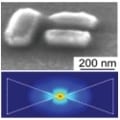 A recent concept article gives a round-up of how nanoplasmonic technology can be employed to control optical properties by use of appropriately shaped nanostructures.
A recent concept article gives a round-up of how nanoplasmonic technology can be employed to control optical properties by use of appropriately shaped nanostructures.
Nanoplasmonics is the science behind light-matter interactions and it can be used to manipulate light flow through or around nano-sized objects. The fact that small objects scatter light has been known since Lord Rayleigh’s time, in the 19th century, and his theory explains why the sky is blue. However developments since Rayleigh’s time were slow to come, until recently.
Nanophotonics as a discipline has evolved rapidly with advances in spectroscopy and highly sensitive detectors, which have allowed scientists to interact with nanoscale objects as never before. The possibility to make metal nanoparticles in a controlled and reproducible way has enabled fundamental advances as the particles can act as tiny antennae for light and enhance the amount of light observed locally. This effect is a part of the local surface plasmon resonance (LSPR) effect which is becoming so important in sensing and imaging applications; understanding this effect is vital to improving existing technologies.
This concept article presents some of the most important recent theoretical and experimental achievements in nanophotonics. It should become a reference for anyone working in this emerging field and an introduction for those new to the area. The authors claim that nanoplasmonics can open up a bright future.

















